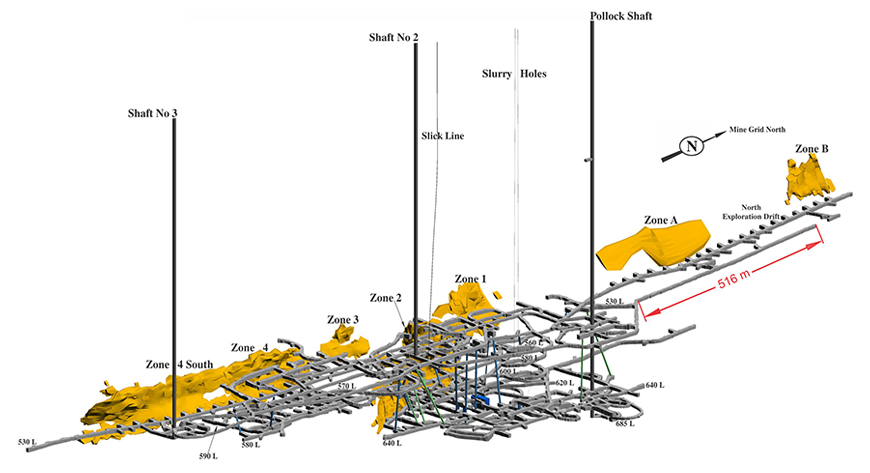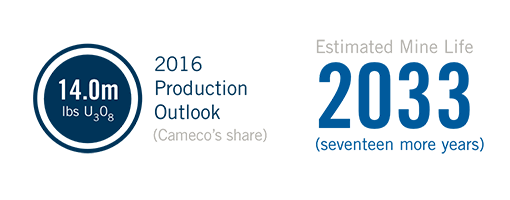McArthur River Mine/Key Lake Mill

McArthur River is the world’s largest, high-grade uranium mine, and Key Lake is the world’s largest uranium mill.
Ore grades at the McArthur River mine are 100 times the world average, which means it can produce more than 19 million pounds per year by mining only 150 to 200 tonnes of ore per day. We are the operator of both the mine and mill.
McArthur River is one of our three material uranium properties.
|
All values shown, including reserves and resources, represent our share only, unless indicated. |
||
| Location | Saskatchewan, Canada | |
| Ownership |
McArthur River – 69.805% Key Lake – 83.33% |
|
| Mine type | Underground | |
| Mining methods |
Primary: raiseboring Secondary: blasthole stoping, boxhole boring |
|
| End product | Uranium concentrates | |
| ISO certification | ISO 14001 certified | |
| Estimated reserves | 234.9 million pounds (proven and probable), average grade U3O8: 10.94% | |
| Estimated resources |
3.9 million pounds (measured and indicated), average grade U3O8: 3.77% 40.9 million pounds (inferred), average grade U3O8: 7.72% |
|
| Licensed capacity | Mine and mill: 25.0 million pounds per year | |
| Licence term | Through October, 2023 | |
| Total production: | 2000 to 2015 1983 to 2002 |
291.1 million pounds (McArthur River/Key Lake) (100% basis) 209.8 million pounds (Key Lake) (100% basis) |
| 2015 production | 13.3 million pounds (19.1 million pounds on 100% basis) | |
| 2016 production outlook | 14.0 million pounds (20.0 million pounds on 100% basis) | |
| Estimated decommissioning cost |
$48 million – McArthur River (100% basis) $218 million – Key Lake (100% basis) |
|
Background
Mining methods and techniques
We use a number of innovative methods to mine the McArthur River deposit:
Ground freezing
The sandstone that overlays the deposit and basement rocks is water-bearing, with large volumes of water under significant pressure. We use ground freezing to form an impermeable wall around the area being mined. This prevents water from entering the mine, and helps stabilize weak rock formations. To date, we have isolated six mining areas with freezewalls.
Raisebore mining
Raisebore mining is an innovative non-entry approach that we adapted to meet the unique challenges at McArthur River. It involves:
- drilling a series of overlapping holes through the ore zone from a raisebore chamber in waste rock above the mineralization
- collecting the broken ore at the bottom of the raises using line-of-sight remote-controlled scoop trams, and transporting it to an underground grinding circuit
- once mining is complete, filling each raisebore hole with concrete
- when all the rows of raises in a chamber are complete, removing the equipment and filling the entire chamber with concrete
- starting the process again with the next raisebore chamber

McArthur River currently has six areas with delineated mineral reserves and delineated mineral resources (zones 1 to 4, zone 4 south and zone B) and two additional areas with delineated mineral resources (zone A, McArthur north). We are currently mining zone 2 and zone 4.
Zone 2 has been actively mined since production began. It is divided into four panels (panels 1, 2, 3 and 5) based on the configuration of the freezewall around the ore. As the freezewall is expanded, the inner connecting freezewalls are decommissioned in order to recover the uranium that was inaccessible around the active freeze pipes. Panel 5 represents the upper portion of zone 2, overlying part of the other panels. The majority of the remaining zone 2 proven mineral reserves are in panel 5.
Zone 4 is divided into three mining areas: central, north and south. We are actively mining the central and north areas.
The Canadian Nuclear Safety Commission (CNSC) has granted approval for the use of two secondary extraction methods: blasthole stoping and boxhole boring.
Our use of blasthole stoping as an ore extraction method has increased as a result of the significant productivity improvements we have achieved with this method. The amount of ore extracted from a single stope can be equivalent to four to eight raisebore holes, resulting in more efficient mining, less waste rock handling, less backfill placement and lower backfill dilution in the ore shipped to Key Lake.
We have used the approved mining methods to successfully extract over 290 million pounds (100% basis) since we began mining in 1999. Raisebore mining is scheduled to remain the primary extraction method over the life of mine, although we now expect to mine a significant portion of the remaining reserves with blasthole stoping.
Blasthole stoping
Similar to raiseboring, blasthole stoping requires establishing drill access above the mineralization and extraction access below the mineralization. We begin each stope with a single raisebore hole (explained above). The stope is then formed by expanding the circumference of the raise by drilling longholes around the raisebore hole and blasting the ore. The blasted material funnels into the raisebore hole and drops to the extraction level below. The broken rock is collected on the lower level and removed by line-of-sight remote-controlled scoop trams, then transported to the grinding circuit. Once a stope is mined out, it is backfilled with concrete to maintain ground stability and allow the next stope and/or raise to be mined. This mining method has been used extensively in the mining industry, including uranium mining.
We continue to employ blasthole stoping only in areas where the longholes can be accurately drilled, and where stable stopes can be excavated without jeopardizing the integrity of the freezewall.
Boxhole boring
Boxhole boring is similar to the raisebore method, but the drilling machine is located below the mineralization, so development is not required above the mineralization. This method is currently being used at a few mines around the world, but had not been used for uranium mining prior to testing at McArthur River.
Test mining to date has identified this as a viable mining option; however, only a minor amount of ore is scheduled to be extracted using this method.
Initial processing
We carry out initial processing of the extracted ore at McArthur River:
- the underground circuit grinds the ore and mixes it with water to form a slurry
- the slurry is pumped 680 metres to the surface and stored in one of four ore slurry holding tanks
- it is blended and thickened, removing excess water
- the final slurry, at an average grade of 15% U3O8, is pumped into transport truck containers and shipped to Key Lake mill on an 80 kilometre all-weather road
Water from this process, including water from underground operations, is treated on the surface. Any excess treated water is released into the environment.
2015 update
Production
Production from McArthur River/Key Lake was 19.1 million pounds; our share was 13.3 million pounds. This was 3% lower than our forecast for the year due to unplanned maintenance outages to repair the calciner at Key Lake. Annual production was unchanged from 2014.
Licensing and production capacity
In 2015, the CNSC approved our application to increase McArthur River’s licensed annual production to 25 million pounds (100% basis) to allow flexibility to match the approved Key Lake mill capacity. The licence conditions handbooks for these operations now allow both operations to produce up to 25 million pounds (100% basis) per year.
Key Lake extension and McArthur River production expansion
In support of our strategy to maintain the flexibility to respond to market conditions as they evolve, we continue to advance projects that are necessary to sustain and increase production when the market signals that additional production is needed.
The Key Lake mill began operating in 1983 and we continue to upgrade circuits with new technology to simplify operations and improve environmental performance. The extension project involved increasing our tailings capacity and the mill’s nominal annual production rate to closely follow production from the McArthur River mine. As part of the mill upgrades, we continue to construct and commission a new calciner circuit, and expect to begin operating with the new calciner in 2016. The existing calciner circuit will remain in place until operational reliability of the new calciner is achieved. The calciner replacement project was planned in a way that temporarily allows us to use either calciner, which will help to mitigate risks to our production rate during the commissioning phase. In order to increase production at Key Lake, we also need to optimize and expand the solvent extraction and crystallization circuits in the mill (projects planned for 2017).
At McArthur River, we must continue to successfully transition into new mine areas through mine development and investment in support infrastructure. We plan to:
- improve our dewatering system and expand our water treatment capacity as required to mitigate capacity losses, should mine development increase background water volumes
- expand the concrete distribution systems and batch plant capacity
New mining areas
New mining zones and increased mine production require increased freeze capacity and ventilation. In 2015, we continued to upgrade our electrical infrastructure on surface as part of our plan to address these future needs. We advanced groundworks to prepare for the next freeze plant, which is scheduled to begin freezing the south end of the orebody (zone 4) in 2017.
We also made changes in shaft 2 to increase air flow, resulting in a 15% to 20% improvement in ventilation capacity. The improved ventilation eliminates the need for a new ventilation shaft to support a higher production rate.
Tailings capacity
We expect to have sufficient tailings capacity to mill all the known McArthur River mineral reserves and resources, should they be converted to reserves, with additional capacity to toll mill ore from other regional deposits.
Planning for the future
Production
We plan to produce 20.0 million pounds in 2016; our share is 14.0 million pounds.
Expansion progress
As previously disclosed in our 2012 Technical Report, we plan to reach an annual capacity of 22 million pounds by 2018. The capital required to do so is shown in our 2016 capital spending plan, and in our outlook for investing activities in 2017 and 2018.
As we increase to 22 million pounds per year, we will optimize the capacity of both the Key Lake mill and McArthur River mine with a view to further increasing production to 25 million pounds per year (100% basis), as market conditions improve. Using this approach, we do not expect significant additional growth capital will be required to increase from annual production of 22 million pounds to an annual rate of 25 million pounds. We expect that this paced approach will allow us to extract maximum value from the operation as the market transitions.
Exploration
In 2015, underground drilling further delineated the zone A mineral resources. Underground definition drilling of zone B will be conducted in 2016 and 2017 to provide the information required for engineering work to develop more detailed mining plans.
Managing our risks
Production at McArthur River/Key Lake poses many challenges: control of groundwater, weak rock formations, radiation protection, water inflow, mine area transitioning, and regulatory approvals. Operational experience gained since the start of production has resulted in a significant reduction in risk.
Transition to new mining areas
In order to successfully achieve the planned production schedule, we must continue to successfully transition into new mining areas, which includes mine development and investment in critical support infrastructure.
Water inflow risk
The greatest risk is production interruption from water inflows. A 2003 water inflow resulted in a three-month suspension of production. We also had a small water inflow in 2008 that did not impact production.
The consequences of another water inflow at McArthur River would depend on its magnitude, location and timing, but could include a significant interruption or reduction in production, a material increase in costs or a loss of mineral reserves.
We take the following steps to reduce the risk of inflows, but there is no guarantee that these will be successful:
- Ground freezing: Before mining, we drill freezeholes and freeze the ground to form an impermeable freezewall around the area being mined. Ground freezing reduces but does not eliminate the risk of water inflows.
- Mine development: We plan for our mine development to take place away from known groundwater sources whenever possible. In addition, we assess all planned mine development for relative risk and apply extensive additional technical and operating controls for all higher risk development.
- Pumping capacity and treatment limits: Our standard for this project is to secure pumping capacity of at least one and a half times the estimated maximum sustained inflow. We review our dewatering system and requirements at least once a year and before beginning work on any new zone.
We believe we have sufficient pumping, water treatment and surface storage capacity to handle the estimated maximum sustained inflow.
We also manage the risks listed here.



